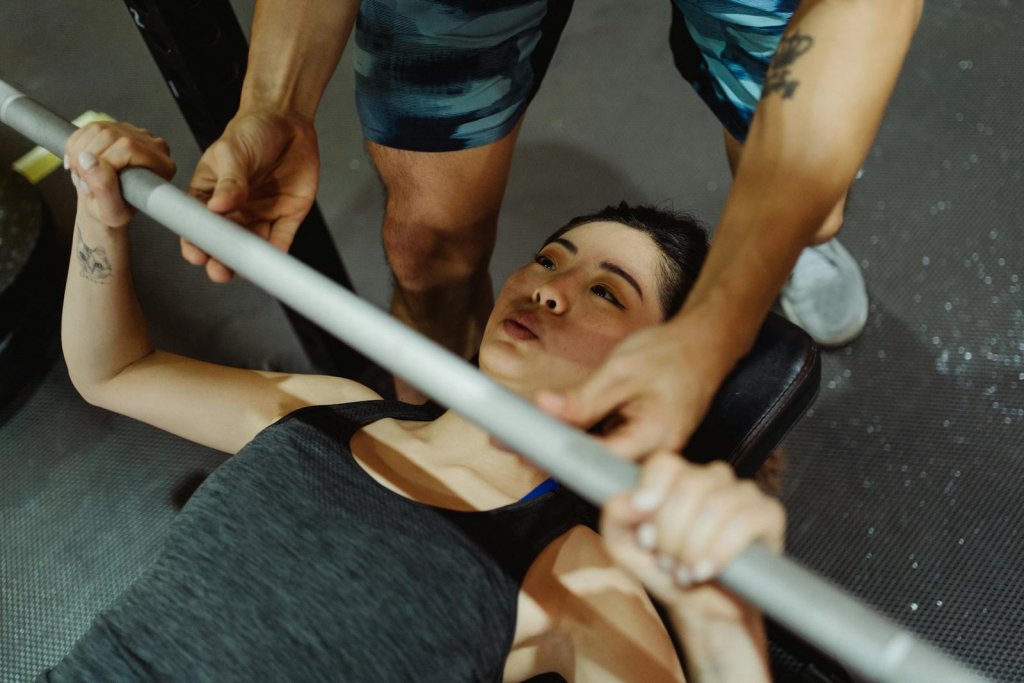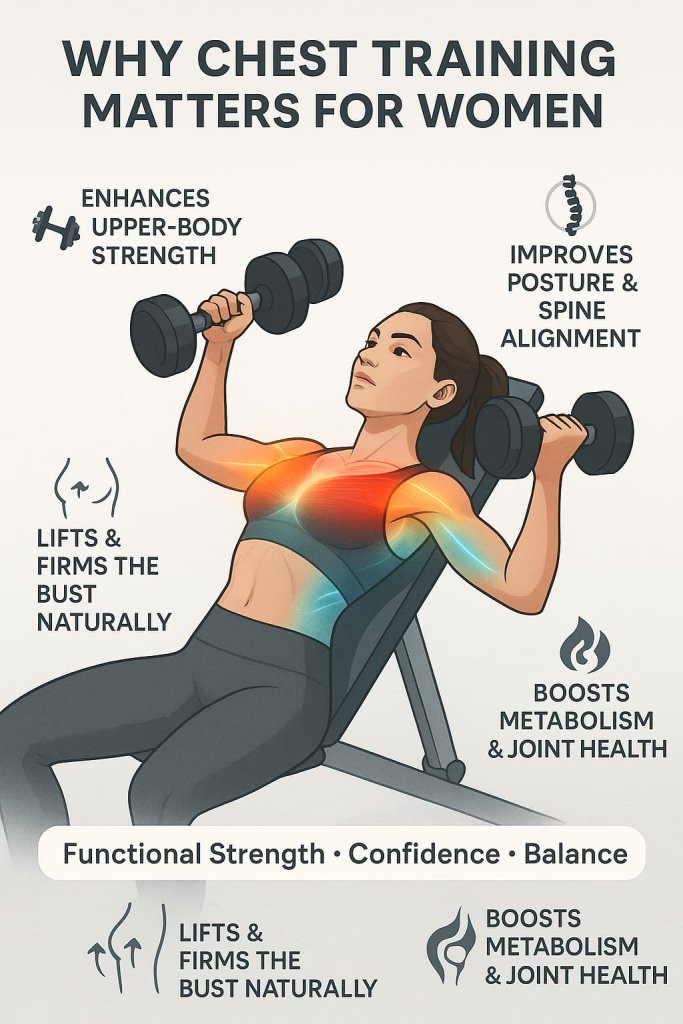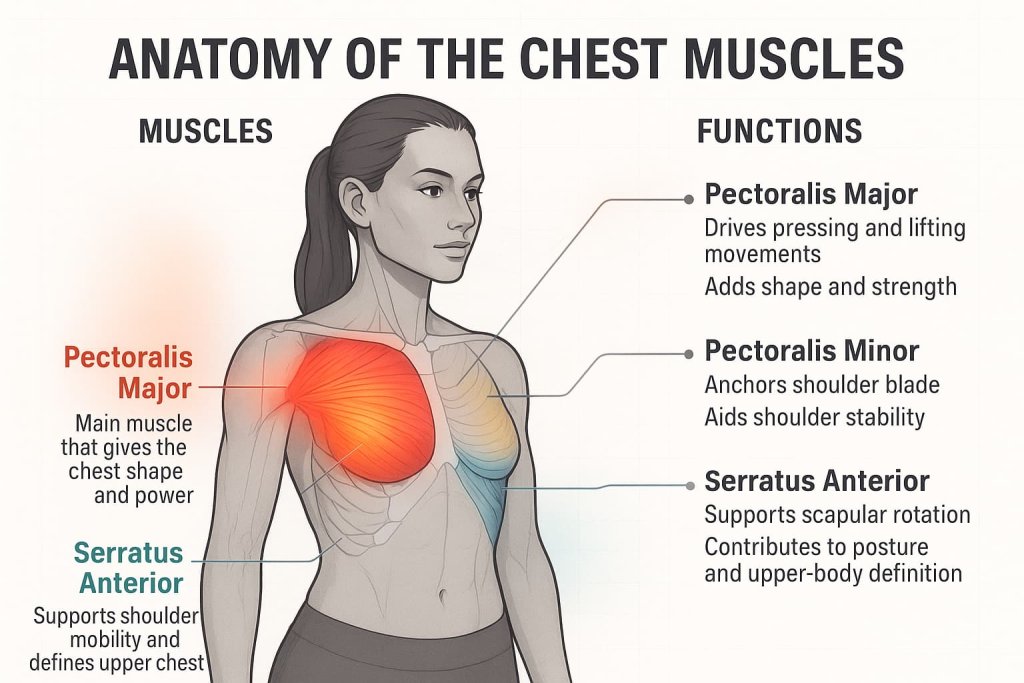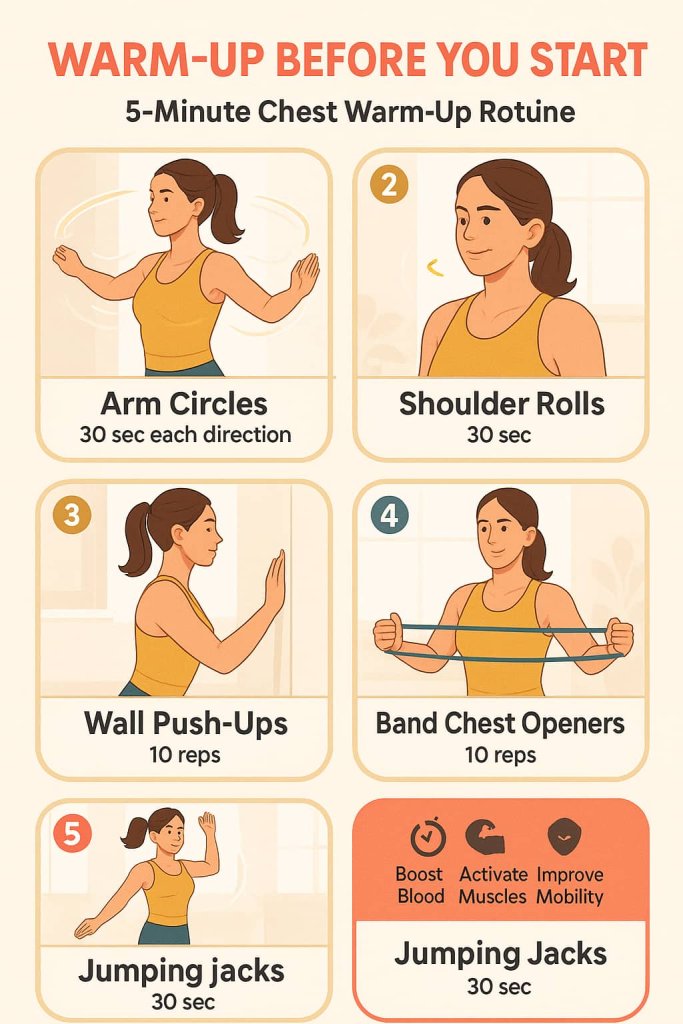The best chest exercises for women help lift, tone, and strengthen the upper body while improving posture and overall muscle balance.
Training the chest isn’t just for men — it’s essential for shoulder stability, better posture, and a firmer, more sculpted upper body. Women who include chest workouts build strength that carries over to daily life, enhances aesthetics, and prevents shoulder or back discomfort.

This guide covers the 21 best chest exercises for women, from beginner-friendly moves to advanced strength-builders — complete with step-by-step instructions, research-backed benefits, and trainer tips to ensure safety and progress.
Why Chest Training Matters for Women
Chest training helps more than aesthetics — it enhances functional strength, joint health, and posture.
Emerging evidence shows that resistance training improves upper-body strength and endurance, while technique and targeted shoulder work influence pectoral activation and shoulder function.

Key Benefits:
- Enhances upper-body strength for daily tasks
- Improves posture and spine alignment
- Lifts and firms the bust naturally
- Boosts metabolism through compound muscle activation
- Supports shoulder and arm performance
Anatomy of the Chest Muscles

The chest (pectoral region) includes:
- Pectoralis major: The main muscle that gives the chest shape and power.
- Pectoralis minor: Lies underneath the major and stabilizes the shoulder blade.
- Serratus anterior: Supports shoulder mobility and helps define the sides of the upper chest.
A balanced workout targets all three areas through presses, flies, and push variations.
Warm-Up Before You Start
Before chest training, warm up your muscles to prevent injury.

5-Minute Warm-Up Routine:
- Arm circles – 30 sec each direction
- Shoulder rolls – 30 sec
- Wall push-ups – 10 reps
- Light resistance band chest openers – 10 reps
- Jumping jacks – 30 sec
21 Best Chest Exercises for Women
These 21 best chest exercises for women help tone, lift, and strengthen your upper body while improving posture and shoulder stability.
They combine bodyweight, dumbbell, and cable movements to sculpt a balanced, firm, and functional chest safely and effectively.
1. Push-Up
Why it works:
The push-up is one of the most effective bodyweight chest exercises for women, targeting the pectorals while simultaneously training the shoulders, triceps, and core. It improves upper-body strength, posture, and functional stability without equipment.
Muscles worked:
Pectoralis major, triceps brachii, anterior deltoids, rectus abdominis, and obliques.
How to do it:
- Start in a plank position with your hands slightly wider than shoulder-width apart.
- Engage your core and glutes to maintain a straight line from head to heels.
- Slowly bend your elbows to lower your chest toward the floor (aim for a 45° elbow angle).
- Press through your palms to return to the starting position, fully extending your arms.
Trainer Tip:
Keep your hips level and avoid letting your lower back sag. If standard push-ups are too difficult, begin with knee or incline push-ups, gradually progressing to full reps.
2. Incline Dumbbell Press
Why it works:
This upper-chest movement develops a lifted, firmer look while improving strength through a larger range of motion than a barbell press. The incline position (30–45°) emphasizes the clavicular head of the pectoralis major — the “upper shelf” of the chest — and activates stabilizers in the shoulders and triceps.
Muscles worked:
Upper pectoralis major, anterior deltoids, triceps.
How to do it:
- Set an incline bench between 30° and 45°.
- Hold dumbbells at shoulder height, palms forward.
- Press the weights upward until your arms are extended but not locked.
- Lower them slowly to just above shoulder level to maintain constant tension.
Trainer Tip:
Avoid arching your back. Keep your feet flat, core tight, and shoulder blades retracted to protect your rotator cuff and maximize upper-chest engagement.
3. Dumbbell Fly
Why it works:
This isolation movement stretches the pectorals deeply while improving definition and symmetry. It’s excellent for developing the outer and inner chest, improving flexibility, and creating a sculpted appearance.
Muscles worked:
Pectoralis major (sternal and clavicular heads), anterior deltoids.
How to do it:
- Lie on a flat bench holding dumbbells above your chest, palms facing each other.
- With a slight bend in your elbows, slowly open your arms in a wide arc until you feel a stretch in your chest.
- Bring the dumbbells back together directly above your chest, squeezing your pecs.
Trainer Tip:
Avoid lowering too far — a 90° elbow angle is enough. The goal is muscle stretch and contraction, not joint strain.
4. Cable Crossover
Why it works:
The cable crossover provides continuous tension throughout the movement, which dumbbells can’t replicate. It emphasizes inner-chest fibers and improves muscle shape and definition, especially when performed at varying cable heights.
Muscles worked:
Pectoralis major, pectoralis minor, anterior deltoids.
How to do it:
- Set both pulleys slightly above shoulder height.
- Stand between them with one foot slightly forward for balance.
- With a slight elbow bend, pull handles downward and across your body until your hands meet at chest height.
- Slowly return to the start position.
Trainer Tip:
Experiment with high-to-low or low-to-high cable positions to target different areas of the chest. Exhale during the squeeze for better muscle contraction.
5. Bench Press (Barbell or Dumbbell)
Why it works:
This classic strength exercise develops total chest power and size while engaging shoulders and triceps for pushing force. It’s the foundation of most upper-body routines for both men and women.
Muscles worked:
Pectoralis major, triceps brachii, anterior deltoids.
How to do it:
- Lie flat on a bench with feet firmly on the floor.
- Grip bar (or dumbbells) slightly wider than shoulder-width.
- Lower the bar slowly to mid-chest level.
- Press upward until arms are fully extended.
Trainer Tip:
Keep shoulder blades pulled back and avoid bouncing the weight off your chest. Controlled, full-range motion delivers better strength and safety.
6. Wall Push-Up
Why it works:
Ideal for beginners or warm-ups, wall push-ups strengthen the chest and triceps with minimal joint strain, helping build a foundation for standard push-ups.
Muscles worked:
Pectoralis major, triceps, anterior deltoids, core stabilizers.
How to do it:
- Stand about 2 feet from a wall with palms flat at shoulder height.
- Bend elbows and lean in, lowering chest toward wall.
- Push back to the start position.
Trainer Tip:
Increase difficulty by stepping farther back or performing the movement on your toes for extra core engagement.
7. Decline Dumbbell Press
Why it works:
This variation targets the lower portion of the chest, rounding out the pectorals and providing balanced development from top to bottom.
Muscles worked:
Lower pectoralis major, triceps, anterior deltoids.
How to do it:
- Lie on a decline bench, holding dumbbells over your chest.
- Lower weights in a controlled manner until they’re in line with your lower chest.
- Press upward without locking elbows.
Trainer Tip:
Avoid extreme decline angles. A mild angle (15–20°) maintains comfort and optimal chest recruitment.
8. Chest Press Machine
Why it works:
Machine presses offer guided motion and safety while allowing heavier loads or higher volume training. Excellent for controlled chest isolation.
Muscles worked:
Pectoralis major, triceps brachii.
How to do it:
- Sit tall and adjust the seat so handles align with mid-chest.
- Grip handles and press forward until arms are extended.
- Return slowly, keeping tension on the chest.
Trainer Tip:
Do not allow weights to touch between reps — this maintains continuous muscle activation.
9. Stability Ball Push-Up
Why it works:
Adding a stability ball increases core challenge and improves shoulder balance, making it a dynamic full-body chest move.
Muscles worked:
Chest, shoulders, triceps, core.
How to do it:
- Place hands shoulder-width apart on a stability ball.
- Extend legs behind you into plank position.
- Lower chest toward the ball slowly.
- Push back up with control.
Trainer Tip:
Engage your abs and glutes to steady the ball. Beginners can start with hands on a bench instead.
10. Resistance Band Chest Press
Why it works:
Portable, low-impact, and effective — this exercise builds tone, stability, and endurance in the chest while protecting joints.
Muscles worked:
Pectoralis major, triceps, shoulders.
How to do it:
- Anchor band behind you at chest height.
- Hold handles with elbows bent and palms down.
- Step forward to create resistance.
- Press arms straight forward, then return under control.
Trainer Tip:
Keep your torso stable and avoid leaning forward — maintain tension throughout the set.
11. Incline Push-Up
Why it works:
A great stepping stone for beginners. It reduces load on the shoulders and wrists while still targeting the chest effectively.
Muscles worked:
Chest, triceps, anterior deltoids, core.
How to do it:
- Place hands on a sturdy elevated surface.
- Lower your body toward it until elbows reach 90°.
- Push back up to full arm extension.
Trainer Tip:
Squeeze your chest at the top of the movement for enhanced definition and stability.
12. Dumbbell Pullover
Why it works:
This hybrid exercise works both the chest and lats, improving upper-body shape and expansion of the rib cage for better breathing and aesthetics.
Muscles worked:
Pectoralis major, latissimus dorsi, triceps.
How to do it:
- Lie on a flat bench, holding a single dumbbell above your chest.
- Lower the dumbbell in an arc behind your head.
- Pull it back to the start, engaging the chest and lats.
Trainer Tip:
Avoid excessive range — stop when elbows align with your ears to protect shoulders.
13. Floor Press
Why it works:
Limits shoulder rotation, making it safer while effectively targeting the mid-chest and triceps.
Muscles worked:
Pectoralis major, triceps brachii, anterior deltoids.
How to do it:
- Lie flat on the floor, knees bent.
- Hold dumbbells above chest, palms facing forward.
- Lower elbows until they lightly touch the ground.
- Press upward.
Trainer Tip:
Pause briefly at the bottom to eliminate momentum and build strength.
14. Standing Cable Fly
Why it works:
Provides a constant load on the chest throughout the motion, improving muscle tone and symmetry.
Muscles worked:
Pectoralis major, anterior deltoids.
How to do it:
- Set pulleys at chest height and hold handles with palms facing forward.
- Step slightly forward and pull handles together in front of your chest.
- Slowly return to start position.
Trainer Tip:
Keep a slight elbow bend and maintain a soft knee position to stabilize your stance.
15. Sphinx Push-Up
Why it works:
This bodyweight movement enhances triceps and lower-chest strength while training shoulder stability.
Muscles worked:
Pectoralis major, triceps, core.
How to do it:
- Begin in forearm plank position.
- Push your hands into the ground to lift onto your palms.
- Lower back down slowly.
Trainer Tip:
Keep your body straight and elbows tucked close for maximal triceps engagement.
16. Pec Deck Fly
Why it works:
A controlled isolation exercise that targets chest fibers precisely, allowing maximum squeeze and contraction.
Muscles worked:
Pectoralis major.
How to do it:
- Sit on the machine, adjusting handles to chest level.
- With elbows slightly bent, bring handles together in front of your chest.
- Slowly return to the starting position.
Trainer Tip:
Pause briefly at the mid-point to increase muscle engagement and definition.
17. Decline Push-Up
Why it works:
Emphasizes the upper chest and front shoulders while increasing the challenge through elevated feet.
Muscles worked:
Upper pectoralis major, deltoids, triceps.
How to do it:
- Place feet on a bench or step, hands on the floor.
- Lower chest until close to the ground.
- Push back up fully.
Trainer Tip:
Maintain a neutral spine — avoid dropping your head or arching your back.
18. Floor Dumbbell Fly
Why it works:
A safer alternative to bench flyes that protects shoulders while maintaining full chest engagement.
Muscles worked:
Pectoralis major, anterior deltoids.
How to do it:
- Lie flat on the floor, dumbbells above chest.
- Lower arms outward until elbows touch floor.
- Squeeze chest to bring weights back together.
Trainer Tip:
Perform slowly and with control — pause briefly at the bottom for a deep stretch.
19. Band Pull-Apart
Why it works:
Balances chest training by strengthening rear shoulders and upper back, improving posture and joint stability.
Muscles worked:
Chest, rear deltoids, rhomboids.
How to do it:
- Hold a resistance band with straight arms at shoulder height.
- Pull band apart by retracting shoulder blades.
- Slowly return to start.
Trainer Tip:
Keep core tight and avoid shrugging shoulders — focus on controlled movement.
20. Smith Machine Chest Press
Why it works:
Provides guided movement for strength and stability. Great for heavier training or beginners focusing on form.
Muscles worked:
Pectoralis major, triceps, deltoids.
How to do it:
- Lie on bench under Smith bar.
- Grip slightly wider than shoulder-width.
- Lower bar to mid-chest, then press upward.
Trainer Tip:
Use safety stops and keep wrists straight to avoid strain.
21. Kneeling Single-Arm Press
Why it works:
Enhances symmetry, stability, and core coordination by isolating one side at a time.
Muscles worked:
Pectoralis major, triceps, obliques, core stabilizers.
How to do it:
- Kneel on one knee with a dumbbell in the opposite hand.
- Hold weight at chest level, palm facing forward.
- Press upward until arm is extended.
- Lower slowly.
Trainer Tip:
Engage your abs and glutes — don’t let your torso twist or lean toward one side.
Common Mistakes to Avoid
- Arching the back during presses
- Using excessive weight that compromises form
- Skipping warm-up or mobility work
- Neglecting upper and lower chest balance
- Not progressively increasing resistance
Who Should Try These Chest Exercises
These chest exercises are ideal for:
- Women aiming to tone or lift the chest area
- Beginners looking to improve posture and strength
- Intermediate to advanced lifters seeking upper-body balance
- Those training at home or in the gym
Safety and Precautions
- Start with light resistance and increase gradually.
- Avoid overtraining — limit to 2–3 sessions weekly.
- Maintain slow, controlled tempo to protect shoulders.
- Consult a fitness professional if you experience pain or discomfort.
Conclusion
Strong, toned chest muscles support posture, confidence, and upper-body balance. With these 21 best chest exercises for women, you’ll build a firm, lifted chest and enhance your strength safely.
Start light, progress gradually, and stay consistent — strength and confidence will follow.
FAQs
1. Can women build chest muscles without getting bulky?
Yes. Moderate resistance and proper form tone the chest without excessive muscle mass.
2. How often should women train chest muscles?
2–3 times per week, with 48 hours of rest between sessions.
3. Are push-ups enough for chest toning?
Push-ups are excellent, but combining them with presses and flies gives better results.
4. What’s the best home chest exercise for women?
Resistance band press or wall push-up — safe and effective for beginners.
5. Should women lift heavy for chest strength?
Progressive resistance (moderate-to-heavy) promotes strength and definition safely.
6. Do chest workouts lift sagging breasts?
They don’t change breast tissue but strengthen and lift underlying muscles for a firmer appearance.
7. How long before results show?
With consistent training, visible tone improvements occur within 6–8 weeks.
References
- Bench Incline & Upper-Chest Activation (EMG) — confirms ~30° incline best for upper pecs
Rodríguez-Ridao et al., 2020 – Int J Environ Res Public Health. - Push-Ups vs. Bench Press (sex differences, activation & reps) — supports programming bodyweight + load for women
Alizadeh et al., 2020 – J Sports Sci Med (open-access). - Barbell Bench Press vs. Dumbbell Fly (EMG) — justifies pairing presses with flyes for full pec recruitment
Solstad et al., 2020 – Sports. - Cables vs. Selectorized Machines (activation & kinematics) — supports using cable crossovers/flies for constant tension
Signorile et al., 2017 – J Strength Cond Res. - Bench Grip/Angle Variations (EMG across pec heads) — technique cues for maximizing pec activation
Roy et al., 2021 – IUSCA Journal. - Progressive Overload & Set/Rep Guidance — gold-standard progression models for safe results
ACSM Position Stand – Progression Models in Resistance Training (PDF). - Global Activity & Muscle-Strengthening Recommendations — authoritative frequency/safety context (YMYL)
WHO Guidelines on Physical Activity and Sedentary Behaviour (2020). - U.S. Practical Guidance (2×/week strength) — clear language for FAQs and consumer-friendly safety
CDC – Adult Physical Activity Guidelines (updated 2023).
